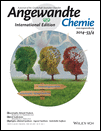Photo-Cross-Linking Probes for Trapping G-Quadruplex DNA†
We thank Prof. Dr. Elmar Weinhold, IOCRWTH Aachen for a fruitful discussion on photo-cross-linking.
Graphical Abstract
Catch me if you can: A readily accessible set of photoactivatable G-quadruplex (G4) ligands with a bisquinolinium core showed high G4-versus-duplex selectivity. Alkylation under UV/Vis irradiation occurred at G4 nucleobases located in either the loops or the external G-quartets (see picture), depending on the cross-linker and the topology of the quadruplex. These probes might be used to irreversibly trap G4 structures for the study of G4 biology.
Abstract
We have developed a straightforward synthetic pathway to a set of six photoactivatable G-quadruplex ligands with a validated G4-binding motif (the bisquinolinium pyridodicarboxamide PDC-360A) tethered through various spacers to two different photo-cross-linking groups: benzophenone and an aryl azide. The high quadruplex-versus-duplex selectivity of the PDC core was retained in the new derivatives and resulted in selective alkylation of two well-known G-quadruplexes (human telomeric G4 and oncogene promoter c-myc G4) under conditions of harsh competition. The presence of two structurally different photoactivatable functions allowed the selective alkylation of G-quadruplex structures at specific nucleobases and irreversible G4 binding. The topology and sequence of the quadruplex matrix appear to influence strongly the alkylation profile, which differs for the telomeric and c-myc quadruplexes. The new compounds are photoactive in cells and thus provide new tools for studying G4 biology.





